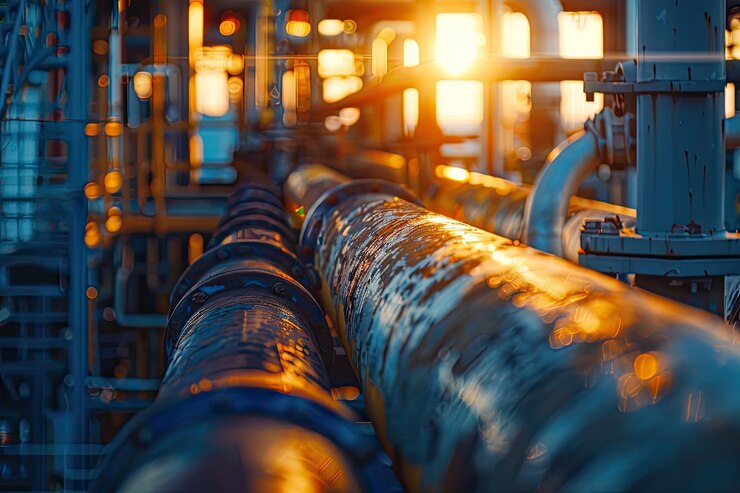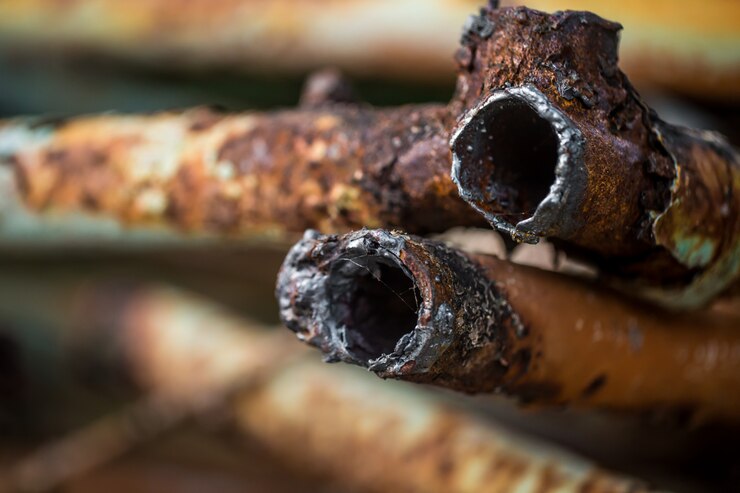Mitigate Risk & Ensure Safety with Efficient Pipeline Corrosion Analysis
- June 18, 2024
- Posted by: Velosi Author
- Categories: Asset Integrity, Insights

Pipeline corrosion analysis functions as one of the leading factors within the oil and gas industry, as it serves as a chief method for safe and effective transport of hydrocarbons. This goes beyond just detection, it practices and incorporates the discovery of the root causes, predicting degradation in the future, and implementing advanced preventive methodologies.
Based on the results of some non-destructive testing, statistical data processing, and risk-based assessment methods, pipeline corrosion analysis provides experts with a sound basis for making the right decisions in terms of maintenance, repairs, and the integrity of pipelines. By adopting an effective corrosion management system, the operators can avoid possible disastrous incidents that may lead to negative environmental impacts, safety issues, and financial instabilities.
Understanding The Basics of Pipeline Corrosion Analysis
Pipeline corrosion happens when pipelines get worn out because of various situations. This can harm the pipelines making them unsafe for their functionality.
Causes of Corrosion
- Environmental Factors: Moisture – High humidity and exposure to water can accelerate rusting. Temperature – Extreme temperatures can cause thermal stress, leading to material degradation.
- Fluid Types: A few transported liquids are more destructive, particularly if they are acidic or contain pollution.
- Pressure: The high weight inside the pipeline can lead to stretch erosion splitting.
- Material Properties: The kind of materials used in making pipelines and how good they are can affect how quickly they get damaged, with some metals being better at resisting damage than others.
Impact on Operations
When pipelines get rusty, they can start leaking or even break open. This causes costly fixes and upkeep, plus it also contributes to a massive problem for the environment and safety. Due to this, it is important to predict and stop corrosion to keep pipelines working well and avoid costly breakdown and maintenance.
Importance of Pipeline Corrosion Analysis
In extensive pipeline corrosion analysis, numerous valuable opportunities are obtained by industrialists working in the oil & gas, and petrochemical sector. Prevention of corrosion hazards reduces the possibility of failure with the adverse impact on the environment, and employees, mainly avoiding huge losses. This facilitates easy repair and maintenance hence increasing efficiency and reducing on cost that would have been incurred in case of a breakdown. Moreover, in the pipeline system, corrosion prevention is done systematically to avoid having to replace quickly the pipelines due to corrosion. Last but not the least, periodical corrosion analysis helps to adhere to the set safety standards.
Essential Aspects
- Data Collection: Acquiring information from different sources such as –Data received from IoT sensors about pipe conditions, history of field technicians and their inspection reports, nominal pipeline, and details of past maintenance and incidents.
- Data Analysis: Techniques such as advanced pattern recognition for corrosion detection, corrosion rate prediction, and pipe AH1 calculation.
- Risk Assessment: Hazard identification and evaluation of the extent of the likelihood of failure in the pipeline and the effects from corrosion analysis carried out above.
- Developing Mitigation Strategies: Publishing the plan and procedure of which corrosion problem will be solved, how the frequency of maintenance will be conducted, how pipelines will be fixed, and any other measure that may be required during the replacement of the pipeline if any.
Causes of Corrosion in Pipelines
Corrosion is a major factor that affects pipelines in the Oil & Gas and Petrochemical industry due to the following relevant factors:
- Internal Corrosion: Since the content of oil and gas depends primarily on their chemical nature. It is a type of corrosion where impurities such as water, oxygen, hydrogen sulfide, and carbon dioxide can react with materials of the pipelines leading to internal degradation. Microbial Induced Corrosion (MIC) is another cause of concern where bacteria that reside in pipelines contribute to the corrosion process.
- External Corrosion: Mainly determined by the external environment the pipeline of structure is in. The presence of moisture disrupts separation with the soil and with other components such as chlorides and sulfates these initiate electrochemical actions that lead to corrosion of the outer surface of the pipelines. Moreover, stray electric current from other sources can also enhance corrosion.
- Flow Regime and Turbulence: Irregularity while using the pipeline can develop some areas with high shear stress as well as turbulence. These areas can cause localized removal of the anti-corrosive oxide film on the pipeline’s wall and expose the metal to corrosion. This is especially the case for the multiphase flow (containing oil and gas and water) or the pipeline’s difference in diameters.
- High Temperatures: Corrosion of many types can progress rapidly at higher temperatures. High temperature also affects the protective coatings and is likely to cause corrosion.
- Welding and Construction Defects: Lack of proper welds or poor quality of the pipeline while constructing the line makes certain weak that are readily attacked by the corrosion process. These imperfections may penetrate the surface of the protective oxide layer, or retain moisture, which increases the rate of corrosion.
- Ageing Infrastructure: Mostly, pipelines in the industry are not replaced for a long time ago due to which corrosion protection coatings also lose their effectiveness, and the base material of the pipelines might become even more vulnerable to corrosion.
- Geological Factors: The underground placement of pipelines can cause a likelihood of corrosion. Hence, it is the soils that either contain high acidity or possess high amounts of corrosive salts that can fasten the rate of deterioration.
- CO2 Acidification: Water being present in pipelines, and dissolved CO2 form carbonic acid which can further be understood that this type of environment can greatly enhance the speed of internal corrosion. This is a trend since more technologies on CO2 capture and storage are developed.
Corrosion, A costly thought
It is estimated that corrosion loses a staggering sum in oil and gas pipelines annually. It also includes repair costs or pipeline replacements as well as the loss of product, the expenses incurred in dealing with the environmental impacts of the spill, and possible fines. Further, pipeline malfunctions pose a potential threat depending on the organization, damaging its reputation and client trust.
Traditional Corrosion Measurement Techniques
Conventional strategies for measuring erosion in pipelines include coordinate estimation methods like ultrasonic testing and radiography.
Ultrasonic Testing:
- Uses high-frequency sound waves to detect thickness changes and flaws in the pipeline.
- Non-invasive and provides immediate results.
Radiography:
- X-rays or gamma rays are used to take pictures inside the pipeline.
- Finds cracks, rust, and other problems.
Limitations of Traditional Corrosion Measurement Techniques
- High costs: It costs a lot of money to have expensive equipment and skilled technicians, and it can be expensive to do frequent inspections.
- Time Consumption: Inspections take a long time and can stop pipeline operations, causing downtime.
- Risks for Technicians: Technicians might get hurt or sick due to hazardous environment.
- Impracticality for Old Pipelines: Old pipelines are hard to check because they are underground and may be fragile. Old ways might not work for buildings that are falling apart.
Solutions to Mitigate Corrosion
Fortunately, there are several strategies to mitigate corrosion and ensure pipeline integrity:
- Material Selection: Selecting the right material such as high-nickel alloys, or stainless steel for the pipelines can highly improve their durability.
- Protective Coatings: Internal and external coating involves putting a layer between the pipeline and the environment which leads to corrosion. One has to make routine checks and has to reapply them when the coating seems to degrade.
- Cathodic Protection: This technique employs an impressed current or sacrificial anode to cause the pipeline surface to become cathodic hence withdrawing the ongoing corrosion procedure.
- Corrosion Inhibitors: Some of the protective measures include the use of chemicals that can be injected into the pipeline and form a film on the internal side of the pipeline which decreases the corrosiveness of the transported fluids.
- Pipeline Analysis and Monitoring: Constant use of external leak detection systems which help in the early detection of corrosion threats to prevent further damage.
Velosi’s PIMS Software
Velosi’s Pipeline Integrity Management System (PIMS) software takes pipeline corrosion analysis to another level, this custom-based advanced software empowers organizations to proactively manage corrosion threats, ensuring pipeline safety, maximizing uptime, and minimizing costs.
Comprehensive Data Integration for Informed Analysis
Pipeline Corrosion Analysis is imperative, Velosi’s PIMS software acts as a central hub for all your pipeline data. It seamlessly integrates data from various sources, including:
- IoT Sensors: Real-time data on pressure, temperature, and other key pipeline parameters is automatically collected and stored.
- Field Technician Measurements: Inspection data and manual measurements collected by technicians in the field are readily accessible within the software.
- Pipeline Specifications: Material composition, design details, and historical performance data of the pipeline are incorporated for a holistic view.
- Historical Records: Past incidents, maintenance history, and any previous corrosion issues are documented and readily available for analysis.
Advanced Analytics for Accurate Corrosion Prediction
Velosi’s PIMS software utilizes sophisticated analytical tools to unlock valuable insights. The tools assist with the following specifications:
- Identify patterns and trends: The software analyzes vast amounts of data to uncover subtle patterns that may indicate potential corrosion threats.
- Predict corrosion progression: By analyzing historical data and current trends, the PIMS software can predict the potential development of corrosion, allowing for proactive maintenance.
- Optimize maintenance strategies: Based on the predicted corrosion risks, the software assists in prioritizing maintenance activities, focusing resources on the most critical areas.
Conclusion
In conclusion, an inspection of the pipeline integrity in accordance with international standards of API 1160 and ASME B31, Velosi provides a Pipeline Integrity Management System (PIMS Software) suitable for onshore and offshore applications. All the industry practices are followed by dedicated professionals for the completion of projects by analyzing the possibilities of risk and preventing or avoiding them from causing shutdowns.
Stay connected for more blogs!
Please contact us for more information and assistance.




